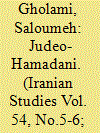| Srl | Item |
| 1 |
ID:
165769


|
|
|
|
|
| Summary/Abstract |
About 150 years ago, after Avestan researchers such as Jackson, Browne, and Westergaard had unsuccessfully attempted to discover new manuscripts in Iran, it was assumed that there were few or no Avestan manuscripts remaining in Iran. However, recent research and fieldwork in Iran have resulted in important findings disproving this assumption. Since 2011, more than eighty-five Avestan manuscripts have been discovered in Iran. One of these important discoveries has been Pouladi’s Collection, which was found in February 2016 in a Zoroastrian house in the Priests’ Quarter (Mahalle-ye Dastūrān) in Yazd. This article deals with the secondary life of Avestan manuscripts of Pouladi’s Collection, focusing on colophons and marginal notes.
|
|
|
|
|
|
|
|
|
|
|
|
|
|
|
|
| 2 |
ID:
179392


|
|
|
|
|
| Summary/Abstract |
The topic of “Endangered Languages” has come more into the focus of public and academic debate in recent years and is being discussed by numerous scholars. The Iranian languages are a branch of the Indo-Iranian languages, which are in turn a branch of the Indo-European language family. As of 2008, there were an estimated 150 to 200 million native speakers of Iranian languages.1 The Ethnologue (2019)2 estimates that there are eighty-six Iranian languages; the most prominent of these are Persian, Pashto, Balochi and the Kurdish group.
|
|
|
|
|
|
|
|
|
|
|
|
|
|
|
|
| 3 |
ID:
180017


|
|
|
|
|
| Summary/Abstract |
The study of the language of religious minorities in Iran is particularly important for understanding the historical development and typology of Iranian languages. Historical and linguistic evidence substantiates the idea that Zoroastrians and Jews in cities in central and western Iran preserved their former vernacular language, whereas the majority of the population replaced it with Persian in the New Iranian period. This paper focuses on the language of Jews in Hamadan and has two main objectives: first, it examines numerous distinctive features of Judeo-Hamadani; second, it reviews and updates recent research to clarify the language origins, using data from new materials recorded during fieldwork in Hamadan from October 2018 to August 2019, and in Yazd in 2017.
|
|
|
|
|
|
|
|
|
|
|
|
|
|
|
|
| 4 |
ID:
157842


|
|
|
|
|
| Summary/Abstract |
Zoroastrian Dari, also known as Behdini or Gavruni, is an endangered Iranian language spoken by the Zoroastrian minority who mostly live in Yazd and the surrounding areas as well as in Kerman and Tehran. Zoroastrian Dari is a unique Iranian language on account of its historical background and large number of subdialects. This language is only a spoken language and not a written one, but it seems that remnants of this language are attested in the Avestan manuscripts, particularly in the colophons. This paper provides a study of the existence of Zoroastrian Dari in the personal names in the colophons and Sālmargs of the Avestan manuscripts.
|
|
|
|
|
|
|
|
|
|
|
|
|
|
|
|